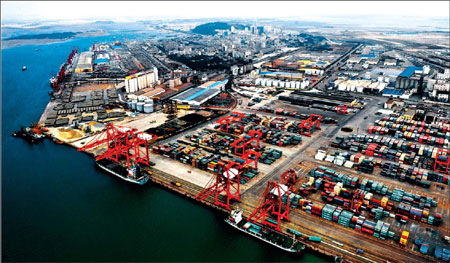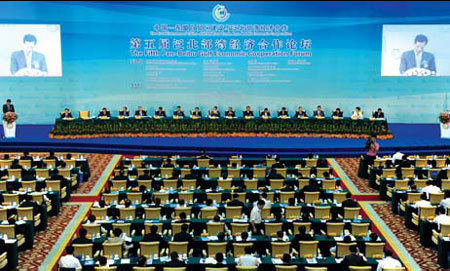Pan-Beibu Gulf cooperation increases trade
Huang Zhaohua and Huang Feifei ( China Daily )
Updated: 2011-08-17
|
One port on the Beibu Gulf in Guangxi, where maritime transportation is the new developmental priority. Zhou Junchen / for China Daily |
|
Last year's Beibu Gulf cooperation forum. Chen zhuofan / for China Daily |
The China-ASEAN Free Trade Area, which officially opened in January 2010, has witnessed rapid growth in bilateral trade and cooperation in the pan-Beibu Gulf region, and has become a model of China-ASEAN cooperation.
In the first half of this year alone, trade between China and ASEAN member countries increased 25.4 percent, to $171.12 billion, according to China Customs statistics from July.
Chinese imports from ASEAN countries for the first half amounted to $91.03 billion, a year-on-year increase of 26.6 percent. Exports to Southeast Asian countries were worth $80.08 billion, up 24 percent.
The free trade area covers parts of China, Vietnam, Malaysia, Singapore, Indonesia, the Philippines, Thailand and Brunei.
This regional cooperation began with the Pan-Beibu Gulf Economic Cooperation Forum, an annual affair that started in 2006, in Nanning, the capital of the Guangxi Zhuang autonomous region.
More than 10 central government's departments - including the National Development and Reform Commission and the Ministry of Commerce - and provincial governments of Guangxi, Guangdong and Hainan, as well as Thailand's Ministry of Commerce have hosted the annual event since 2006.
The forum attracted about 120 ministerial officials in the concerned countries and more than 2,000 globally renowned experts and entrepreneurs over the past five years.
The sixth forum will be held Aug 18 to 19 this year, to explore further ways to cooperate in transportation, finance, and tourism.
Cooperation mechanism
A panel of experts on Beibu Gulf cooperation was established in 2008, following a proposal by China and supported by ASEAN members .
The result was that the regional cooperation was operating within the China-ASEAN cooperation framework.
And, China established a secretariat for regional cooperation in 2009.
The expert panel approved a feasibility study on regional cooperation at its fourth annual meeting in 2011. The meeting discussed the priority areas for further collaboration and made proposals for that.
Regular panel meetings are an important mechanism for promoting regional cooperation. They examine a wide rang of regional issues and provide support to policymakers in the countries concerned.
Those countries have been able to cooperate in various infrastructure projects involving ports, railways, and roads.
Pilot area
Authorities in major Beibu Gulf ports are also working on a regional port service network.
At last year's forum, the Guangxi Beibu Gulf International Port Group Ltd signed agreements with other Chinese ports and ASEAN shipping and port firms.
A Guangxi-invested economic and trade zone was established in Indonesia in 2007.
During a China-Malaysia trade and investment forum in April, China's Premier Wen Jiabao said, "The China-Malaysia industrial park in Qinzhou, Guangxi is the first of its kind in that part of China and a significant demonstration area."
The park is expected to cover a 49-square-kilometer area for advanced manufacturing as a major cooperation project for the two countries, and to provide a fast channel for Malaysian investment in the mainland.
Financial cooperation is expanding. The Development Bank of Singapore has a branch in Nanning, and Chinese bankers have eight offices in ASEAN countries.
The cooperation covers a range of business, from international settlements to credit, and equity investment.
Meanwhile, trade between China and Indonesia saw good growth in the first half of this year, with a year-on-year increase of 41 percent. That was the highest among ASEAN members. Vietnam took second place, with a 40.9-percent increase.
Nanning-Singapore corridor
In 2008, as an important part of the proposed Nanning-Singapore corridor, the Vietnamese government approved a plan for an industrial zone linking the border town of Lang Son with the capital, Hanoi, and the third largest city Haiphong.
And, work on a large bridge across the Mekong River, linking Nakhon Phanom, Thailand with Thakhek, Laos ,began in 2009. It is expected to open this November.
This bridge will make the trip from Nanning to Bangkok, and on to Kuala Lumpur and Singapore easier, by crossing the middle of Vietnam and central and southern Laos.
One part of this - an expressway from Nanning to Friendship Gate in the town of Pingxiang, Guangxi - has been completed.
Authorities in Guangxi and Vietnam have reached an agreement to build expressways linking the Friendship Gate with the city of Dongxi, in Guangxi, and Hanoi, while at the same time renovating railways from Nanning to Hanoi, and Ho Chi Minh City, Vietnam and Phnom Penh, Cambodia.
Other railways on the Nanning-Singapore network are already in use.
Cross-border zones
Cross-border industrial parks are another popular area of thought in the atmosphere of China-ASEAN cooperation.
Guangxi and Vietnam's Quang Ngai signed an agreement in September 2010 to build just such a zone.
Other China-Vietnam cross-border economic zone are being planned.
One is Dongxing, a national experimental area for development and opening-up. Another is Pingxiang, which is a pilot site for opening up to ASEAN economies, It is China's only comprehensive bonded zone directed connected with a foreign country.
(China Daily 08/17/2011 page12)


